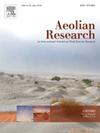大气污染指数与粉尘相关疾病风险水平及住院治疗的关系
IF 3.4
3区 地球科学
Q2 GEOGRAPHY, PHYSICAL
引用次数: 0
摘要
空气质量指数(AQI)、PM10和PM2.5反映了空气污染水平,并用于评估与粉尘有关的疾病和住院的风险水平。以前的研究评估了与单个(如PM10)或多种空气污染物(AQI、PM10和PM2.5)相关的住院率,以检验这些指标在反映健康风险方面的功效。本研究考察了空气污染物(AQI、PM10和PM2.5)和沙尘暴指数(风速、能见度和沙尘暴指数(DSI))在反映健康风险方面的功效。在2022年的13次沙尘暴和2023年的20次沙尘暴期间,扎博尔医疗急救中心接收了呼吸道、眼部和心血管疾病的入院治疗。2022年5月至2023年12月,PM2.5和PM10数据来自扎博尔医科大学,能见度和风速数据来自扎博尔气象站。结果显示:AQI >;在研究期间,随着空气质量指数的增加,住院率也随之增加。2023年6月和7月住院人数最多,与PM10和DSI的最高水平一致。住院人数与空气污染物指数和沙尘暴指数均呈显著正相关。AQI, DSI, Vis <;2公里(能见度<;2 km)和风速的相关性最高(r2 >;81)。AQI与Vis;2公里是导致住院的主要因素。结果表明,AQI、PM10、能见度和DSI可以作为风险沟通和评估粉尘相关疾病和住院风险的工具。本文章由计算机程序翻译,如有差异,请以英文原文为准。

On the relationship between air pollution indices and risk level of dust-related diseases and associated hospitalization
The air quality index (AQI), PM10 and PM2.5 reflect the level of air pollution and are used to assess the risk level of dust-related diseases and hospitalization. Previous studies have assessed the hospital admissions in relation to individual (e.g., PM10) or multiple air pollutants (AQI, PM10, and PM2.5) to examine the efficacy of these indices in reflecting health risks. This study examined the efficacy of air pollutants (AQI, PM10, and PM2.5) and dust storm indices (wind speed, visibility and dust storm index (DSI)) in reflecting health risks. Hospital admissions for respiratory, eye, and cardiovascular diseases were received from the Zabol Medical Emergency Center during 13 dust storm events in 2022 and 20 events in 2023. PM2.5 and PM10 were gathered from the Zabol University of Medical Sciences, and visibility and wind speed were collected from the Zabol meteorological station from May 2022 to Dec 2023. The results revealed AQI > 100 and an increase in hospital admissions with increasing AQI during the period of study. The greatest hospital admissions were observed in June and July 2023, consistent with highest levels of PM10 and values of DSI. Significant positive correlations were found between hospital admissions and both air pollutants and dust storm indices. AQI, DSI, Vis < 2 km (visibility < 2 km) and wind speed showed the highest correlations (r2 > 81). AQI and Vis < 2 km were the dominant factors contributing to hospital admissions. Further, the results suggested that AQI, PM10, visibility, and DSI can function as a tool for risk communication and assessment of dust-related disease and hospitalization risk.
求助全文
通过发布文献求助,成功后即可免费获取论文全文。
去求助
来源期刊

Aeolian Research
GEOGRAPHY, PHYSICAL-
CiteScore
7.10
自引率
6.10%
发文量
43
审稿时长
>12 weeks
期刊介绍:
The scope of Aeolian Research includes the following topics:
• Fundamental Aeolian processes, including sand and dust entrainment, transport and deposition of sediment
• Modeling and field studies of Aeolian processes
• Instrumentation/measurement in the field and lab
• Practical applications including environmental impacts and erosion control
• Aeolian landforms, geomorphology and paleoenvironments
• Dust-atmosphere/cloud interactions.
 求助内容:
求助内容: 应助结果提醒方式:
应助结果提醒方式:


